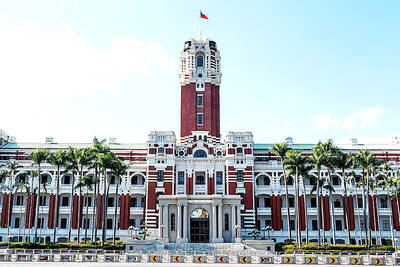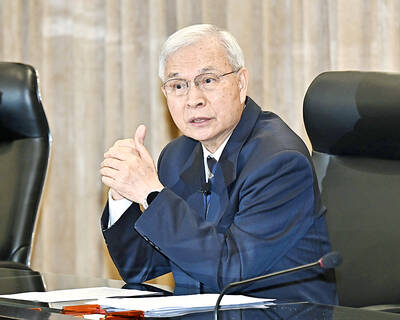Alaska's governor imposed a state hiring freeze because of the millions of dollars in revenue Alaska is losing as a result of a major oil field shutdown, and says he has directed the state attorney general to investigate whether oil company BP could be held fully accountable for the losses.
Earlier this week, London-based BP PLC said it would shut down Prudhoe Bay -- the biggest oil field in the US -- because of a small leak and severe pipeline corrosion. Energy officials have said the pipeline repairs are likely to take months, curtailing Alaskan production into next year.
The expected loss of 400,000 barrels per day (bpd) at today's oil prices means the state is losing about US$6.4 million a day in royalties and taxes, Revenue Commissioner Bill Corbus said.

PHOTO: AP
The state receives 89 percent of its income from oil revenue; Alaska has no state sales tax and no personal income tax. The Prudhoe Bay shutdown will cut in half Alaska's total oil production and the resulting revenue.
Critical
Without money coming in from Prudhoe Bay, Alaska's government can operate for only about two months before going into the red, Corbus said.
"BP must get the entire Prudhoe Bay back up and running as soon as it is safely possible," Governor Frank Murkowski told a joint session of the state legislature on Wednesday.
BP, the world's second-largest oil company, said it would replace 26km of pipeline that carries oil from Prudhoe Bay to the nearly 1,300km Trans-Alaska Pipeline. The Prudhoe Bay field accounts for 8 percent of US domestic output.
"We obviously apologize for the impact this is having on people, and we regret having to take these actions, but our focus is on safe operations and environmental protection, and that's the reason why we've undertaken the action we have," BP spokesman Neil Chapman said.
BP and the US authorities have until today to decide whether the company can maintain some production at the Alaskan oilfield. BP said it was working on two plans, one involving total shutdown of the 400,000bpd field which provides 8 percent of US production, and a second allowing it to keep oil flowing from the western side of the 101,000-hectare site.
"While we have one plan moving forward for the orderly shutdown, we also have a second independent, but parallel plan to look at the possibilities of safely keeping portions of the field operating," Bob Malone, chairman and president of BP America, said.
Decision awaited
BP is carrying out further inspections of 300m of pipe in the western section to assess whether it can continue production, which would run at just under 200,000bpd. The authorities and the company have to reach a conclusion by the weekend, when its shutdown plan is due to be triggered.
"We will be making a decision with the federal and state governments by Friday [today] as to whether we need to continue to take down that line for safety purposes or whether we can maintain production," Malone told US energy analysts in a conference call.
BP has not said how long it expects the replacement programme to take but the US Energy Information Administration said on Tuesday if the field was shut down in its entirety, full production might not be restored until January.
"This production outage forecast is based on BP's initial estimate that the shutdown would last `several' months. Our forecast could change as new information becomes available," the EIA said.
Steve Marshall, president of BP Exploration Alaska, told a conference call that the onset of the Alaskan winter would help rather than hinder the company's replacement program.
"We are far more restricted in the summer months when the tundra is unprotected by a layer of snow and ice. The winter is our friend when it comes to the construction and installation of new equipment and pipe. Productivity does slow down when the temperatures approach minus 60 degrees, but that is several months away," Marshall said.
BP said it was unable to calculate how much the shutdown would cost. Head of investor relations Fergus MacLeod noted that BP's share of the field's production ran at about 100,000bpd and its second-quarter net profit margin was US$25 a barrel.

The CIA has a message for Chinese government officials worried about their place in Chinese President Xi Jinping’s (習近平) government: Come work with us. The agency released two Mandarin-language videos on social media on Thursday inviting disgruntled officials to contact the CIA. The recruitment videos posted on YouTube and X racked up more than 5 million views combined in their first day. The outreach comes as CIA Director John Ratcliffe has vowed to boost the agency’s use of intelligence from human sources and its focus on China, which has recently targeted US officials with its own espionage operations. The videos are “aimed at

STEADFAST FRIEND: The bills encourage increased Taiwan-US engagement and address China’s distortion of UN Resolution 2758 to isolate Taiwan internationally The Presidential Office yesterday thanked the US House of Representatives for unanimously passing two Taiwan-related bills highlighting its solid support for Taiwan’s democracy and global participation, and for deepening bilateral relations. One of the bills, the Taiwan Assurance Implementation Act, requires the US Department of State to periodically review its guidelines for engagement with Taiwan, and report to the US Congress on the guidelines and plans to lift self-imposed limitations on US-Taiwan engagement. The other bill is the Taiwan International Solidarity Act, which clarifies that UN Resolution 2758 does not address the issue of the representation of Taiwan or its people in

US Indo-Pacific Commander Admiral Samuel Paparo on Friday expressed concern over the rate at which China is diversifying its military exercises, the Financial Times (FT) reported on Saturday. “The rates of change on the depth and breadth of their exercises is the one non-linear effect that I’ve seen in the last year that wakes me up at night or keeps me up at night,” Paparo was quoted by FT as saying while attending the annual Sedona Forum at the McCain Institute in Arizona. Paparo also expressed concern over the speed with which China was expanding its military. While the US

SHIFT: Taiwan’s better-than-expected first-quarter GDP and signs of weakness in the US have driven global capital back to emerging markets, the central bank head said The central bank yesterday blamed market speculation for the steep rise in the local currency, and urged exporters and financial institutions to stay calm and stop panic sell-offs to avoid hurting their own profitability. The nation’s top monetary policymaker said that it would step in, if necessary, to maintain order and stability in the foreign exchange market. The remarks came as the NT dollar yesterday closed up NT$0.919 to NT$30.145 against the US dollar in Taipei trading, after rising as high as NT$29.59 in intraday trading. The local currency has surged 5.85 percent against the greenback over the past two sessions, central